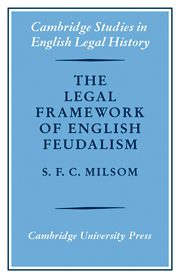3 - Proprietary jurisdiction
Published online by Cambridge University Press: 04 May 2010
Summary
Maitland's picture of the rise of the actions protecting freehold land has a clarity which will never be rivalled. In the beginning there were writs of right, settling as between the parties something we can only think of as the ‘ownership’ of the land. But these were troublesome, and imposed too great a burden on the demandant when his case was obvious. And so possessory protection was provided: first, novel disseisin and mort d'ancestor, and then, by an extension of the idea, the writs of entry. And since the possessory actions but not the proprietary were proper for royal courts, and since they were preferred, jurisdiction was drawn away from lords' courts into the king's.
It is a compelling picture which seems immediately to fit. Could this be because the society into which it fits is one juristically like ours? Like ours, and like that in which the Roman law grew up, it is a society of equal owners disputing about abstract rights of property. There are lords, of course, but what they have are equally just rights of property. Their dues are charged upon the land, but the land nonetheless belongs to the tenant. Even the right to jurisdiction is valuable for the profits of justice; and the lord has nothing else to lose if a case goes to another court. Against this unchanging background, the same for Henry II as it was to be for Edward I, we have supposed jurisdiction being painlessly transferred as possessory protection is extended.
- Type
- Chapter
- Information
- The Legal Framework of English FeudalismThe Maitland Lectures given in 1972, pp. 65 - 102Publisher: Cambridge University PressPrint publication year: 1976
- 1
- Cited by

